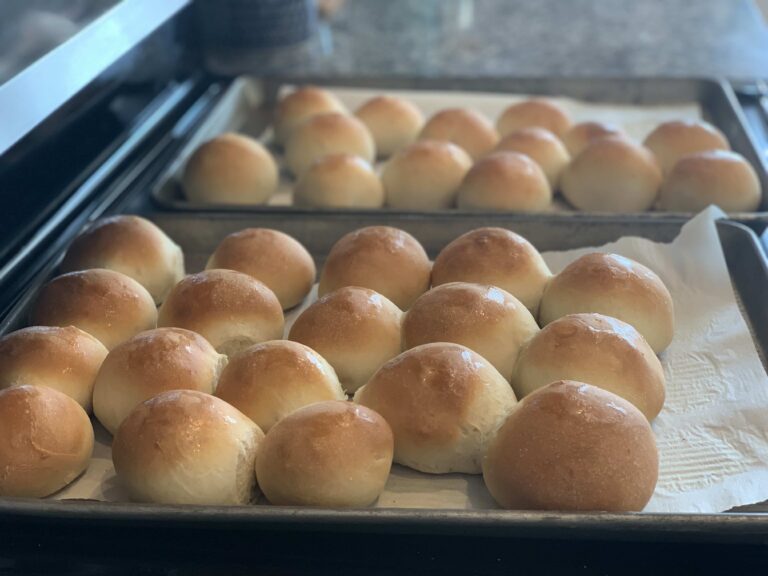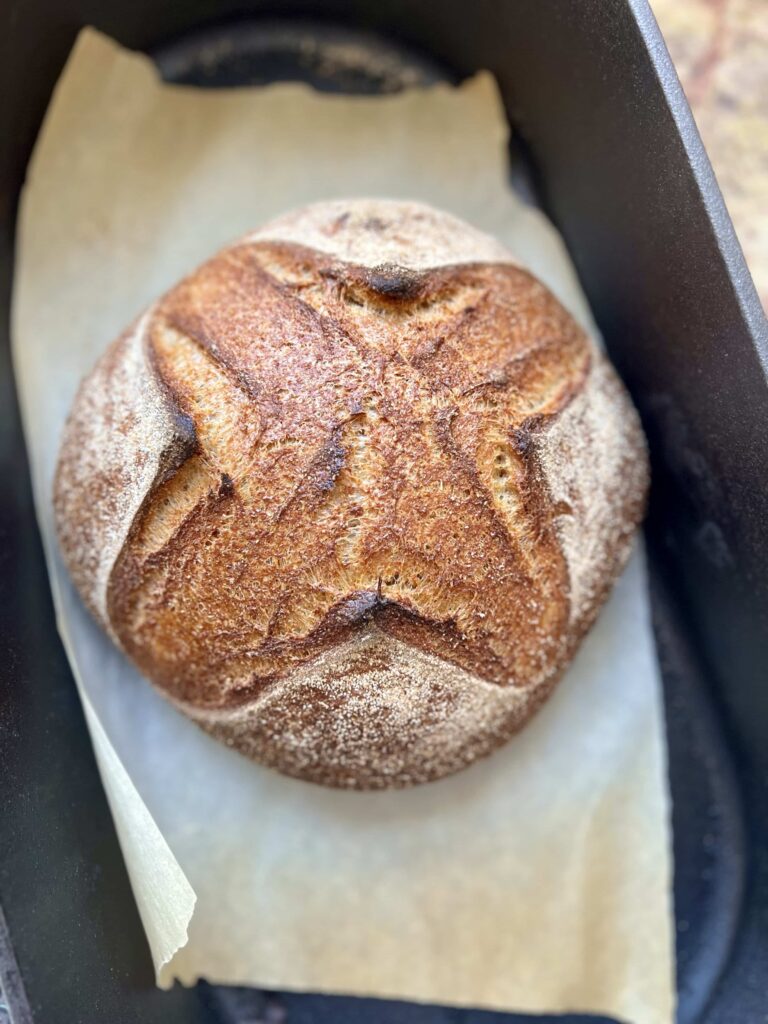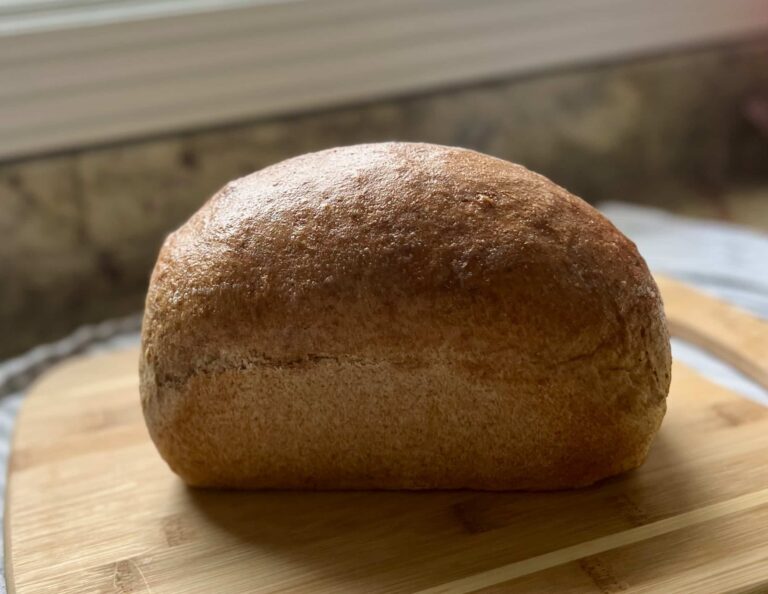Sourdough Baguette Recipe
This post may contain affiliate links. Please read our disclosure policy.Sourdough Baguettes are what sourdough dreams are made of. My family would be happy eating them all day every day. Crispy, crunchy with a soft interior, these baguettes are sure to become your new favorite. I make these with 100% natural yeast (sourdough), in all they take a couple days from start to finish. This recipe is specifically designed for a home baker, so these baguettes are actually a “demi-baguette” – about half the size of a traditional baguette. They are perfect for making sandwiches, dipping in olive oil or just munching on. This sourdough baguette recipe is incredible, a little tricky to shape, but you will get there! I hope you love them as much as I do.

Let’s Set Some Expectations: Making baguettes is a more difficult sourdough recipe. If you are not quite confident working with high hydration dough, I will be honest, shaping them will be a little tricky. But – like anything – the more you do it, the better you will get! Mixing the dough and managing fermentation is not especially difficult. It’s the shaping/proofing process that takes time to learn. It’s also helpful to note that I am gearing this recipe specifically toward a home baker who won’t have an oven large enough to make a regular-sized baguette.



Simple Ingredients in a Sourdough Baguette Recipe
- Sourdough Starter: Use an active/ripe sourdough starter (doubled in size/bubbly/mild sour aroma) to mix the levain.
- All Purpose Flour: I use all purpose flour for my sourdough baguettes with 11.5% protein content. The French, who are known for their baguettes, typically use a T55 flour which is similar to our American all purpose flour. The lower gluten content of an all purpose flour produces a more crackly crust, which makes the sourdough baguette crispy and delicious.
- Water: With only 4 ingredients in this recipe, water is important! You may need to use cold or warm water to balance out the ambient temperature. The goal is to keep the dough right around 78 degrees F throughout the bulk fermentation (more info below). Most of the water is added to the flour in an autolyse, but 50 grams is reserved to add to the autolysed dough before mixing.
- Salt: Salt is added after the autolyse to help the gluten strands develop. It’s important to balance the flavors. Don’t leave it out.

Sample Baking Schedule: Sourdough Baguette Recipe
A sample baking schedule helps me when baking with sourdough. Sourdough takes much longer to rise than traditional bread. This schedule helps me plan my bake. Note: This schedule assumes the dough temperature will be maintained at 78 degrees F throughout the process.
| Day 1 | Mix Levain/Mix Dough/Bulk Fermentation/Cold Fermentation |
| 8:00 AM | Mix Levain |
| 10:30 AM | Autolyse |
| 11:30 AM | Mix Dough Begin Bulk Fermentation |
| 12:00 PM 12:30 PM 1:00 PM | Stretch and Fold #1 Stretch and Fold #2 Stretch and Fold #3 |
| 1:00 PM – 2:30 PM | Finish Bulk Fermentation |
| 2:30 PM | Begin Cold Fermentation |
| Day 2 | Pre-Shape/Shape/Proof/Bake |
| 8:00 AM | Pre-shape sourdough baguettes |
| 8:45 AM – 9:00 AM | Shape sourdough baguettes |
| 9:00 AM | Begin Proofing sourdough baguettes (1.5-2 hours) |
| 10:00 AM | Pre-heat oven with baking stone |
| 11:00 AM | Score and bake first group of baguettes |
| 11:30 AM | Pre-heat oven for second batch of baguettes (if needed) |
| 12:00 PM | Score and bake second group of baguettes |



Making a Levain
I use a levain method for making sourdough. You can read more about that here. For this recipe I use a 3-4 hour levain (1:1:1 ratio):
- 65 grams ripe/mature sourdough starter
- 65 grams all purpose or bread flour
- 65 grams water
Before mixing, take the temperature of the sourdough starter and flour. If it is colder than the 75-80 degree range, use warm water to mix the levain. If the ingredients are warmer than 75-80 degrees, use cooler water. The goal is for the levain to stay in the 75-80 degree temperature range. After mixing, cover loosely and let sit for about 3-4 hours (at 75-80 degrees F). If you want to mix levain overnight so it is ready in the morning, mix a 1:10:10 levain with 9 grams ripe sourdough starter, 90 grams flour and 90 grams water. Let sit for 10-12 hours until bubbly, doubled in size and barely beginning to fall back down.

One Hour Autolyse
This sourdough baguette recipe benefits from an hour long autolyse before mixing the dough. Autolyse refers to a process where flour and water are mixed together and then left to rest. Enzymes break down the proteins in the flour, making the dough stretchy and extensible. This process takes a little extra planning, but gives the baguettes the perfect texture and crumb. Mix together the flour and water. Cover it and let rest for about an hour before adding in the ripe levain, salt and a little extra water.

Bulk Fermentation in Sourdough Baguettes
- Mix Dough: When the levain is ready, add ripe levain, salt and extra water on top of the autolysed dough. Mix together with your hands for about 2-3 minutes, pinching the dough and gently kneading until all the ingredients are fully incorporated. Wet your hands as needed to keep the dough from sticking to your hands during this process. The dough will come together and form a cohesive ball after a few minutes.
- Stretch and Folds: Perform 3 sets of stretch and folds over the first 90 minutes. Every 30 minutes, stretch and fold the dough. Wet your hand (so it doesn’t stick to the dough). Reach down to the bottom of the bowl of dough and pull the dough up and over the top of itself. Turn the bowl 1/4 turn and repeat the stretch and fold. Turn another quarter turn and repeat. Perform one more 1/4 turn with stretching and folding the dough. Cover and set aside.
- Rest: Let the dough rest for the remainder of the bulk fermentation, about 1.5-2 hours. If you keep your dough temperature around 78 degrees, this will take about 3-4 hours TOTAL.



Cold Fermentation in this Sourdough Baguette Recipe
After the dough has finished its bulk fermentation, cover the dough and store it in the refrigerator for about 18 hours. You can let the dough cold ferment any amount of time between 12-48 hours with good results. This gives the sourdough baguettes more flavor and a better structure and crumb. It also makes the baguettes easier to shape.

Shaping Sourdough Baguettes
Pull the dough out of the refrigerator and separate it into 6 equal pieces, about 300 grams each, for demi-baguettes.



Work quickly with the cold dough and shape each piece of dough into a ball. Let the dough sit uncovered for about 45 minutes until relaxed.





Take a piece of dough and flip it over. Fold the bottom half of the dough up to the middle and press to seal. Fold the top half down to the middle and press to seal. This gives you a rectangle shape.




Lightly flour your hands as needed. Turn the rectangle of dough 180 degrees and working from left to right, pull the top edge of the dough into the middle with your left hand. Work down the dough, pulling dough into the middle and forming a cylinder shape. Turn the dough 180 degrees and repeat this process on the other side.




Pinch closed the seam and lightly flour the countertop.


Roll the baguette starting from the middle out. Repeat this process a few times until you’ve reached the desired length of baguette, leaving the edges tapered. Check the size of your baking stone. and make sure the dough is not rolled longer than the baking stone.


Prepare a kitchen towel or bakers couche. (I have also used parchment paper successfully but it needs to be well floured). For a home baker, a non-fuzzy kitchen towel works well. Lightly flour a long kitchen towel, making sure the flour is evenly dispersed throughout. This will keep the baguette dough from sticking to the towel.

Place the baguette, seam side up on one side of the floured kitchen towel. Pull up the edges of the kitchen towel around the baguette, forming a barrier. Repeat this process with the remaining baguettes, nestling them next to each other on the kitchen towel with a small barrier in between. If the dough is sticking, use a little extra flour.



Proofing and Preparing Sourdough Baguettes to Bake
Cover the sourdough baguettes with a kitchen towel and let proof for about 1.5-2 hours in a warm place (78-80 degrees F). The baguettes will puff up a little bit and become airy. Preheat a baking stone in the oven for about an hour before baking your sourdough baguettes. Decide how many baguettes you can bake at the same time. I can fit three in my oven on my baking stone. If you have multiple ovens or multiple stones, you may be able to do more.




Prepare a piece of parchment paper next to the rising baguettes. Gently turn the baguette dough over onto the piece of parchment paper. I use my hands to gently press on the sides of the dough to get it back into the shape I want. Repeat with remaining baguettes. My oven only holds 3 baguettes at a time, so any baguettes that I am not baking right away, I prepare on parchment paper and then stick in the refrigerator to wait their turn to bake. This keeps them from over-proofing.







Scoring Sourdough Baguettes
You can score your baguettes however you like. Sometimes I’ll do one long score down the middle. and other times I like 3 vertical scores for a more traditional look. To get the best score, make sure you are using a bread lame (I love my Wire Monkey lames – and you get 10% off your purchase with my link) and a sharp razor. However you choose to score, work quickly and precisely.





Baking Sourdough Baguettes
Baguettes need a lot of steam to develop that crispy crust and get a beautiful rise in the oven. To get the crispy crust and even bake that best mimics that of a bakery, they should also be baked on a baking stone. Historically, getting enough steam has been difficult for home bakers, because home ovens are built to vent steam, not keep it in. I’ve tested out a few different ways to get that perfect crispy crust that sourdough baguettes are known for. Choose whichever method works better for you:
- Preheat the oven and baking stone to 450 degrees F for about an hour before baking the baguettes. Slide the baguettes into the oven using a pizza peel. Quickly add a pan of boiling water to the bottom rack of the oven (about 2 cups of water) and bake the baguettes for 20 minutes. Remove the pan of water and bake for another 10-15 minutes depending on how dark you want your baguettes.
- Preheat the oven and baking stone to 475 ºF for about an hour before baking the baguettes. Add about a cup of ice cubes to a baking pan. Place the baking pan on the rack underneath the baking stone. Quickly slide the baguettes into the oven and bake for 8 minutes. Then reduce the temperature to 450ºF and bake for another 22-25 minutes.


Baking Another Batch of Baguettes
I use a pizza peel to pull the baked baguettes out of the oven and transfer them to a cooling rack. Then it’s time to bake my next batch! My oven can fit about 3 baguettes on my baking stone. Before baking, it’s important to preheat the oven again for about 10-15 minutes before baking the next batch of baguettes. This will ensure a crispy crust, better color and oven spring. Pull the shaped baguettes out of the refrigerator and transfer them to the pizza peel (putting the baguette dough on parchment paper really helps with this step). Score and launch into your preheated oven using your desired method of steaming. Bake and then let cool before slicing and enjoying!

Frequently Asked Questions
We eat them at room temperature for the first 24 hours and then I like to freeze the baguettes whole in a ziplock or bread bag. When we want to eat one we’ll thaw it out, spritz/douse with water and pop it in a 350 degree oven for 10 minutes or so until crispy again.
I have made these baguettes many times and in my experience, the baguettes where I used an autolyse turned out better than the ones I did not. If you are short on time, you can mix all the ingredients together (ripe levain, all purpose flour, water and salt) and leave out the autolyse. The resulting baguette will still taste good, but I think it’s worth the extra time when you remember to perform an hour-long autolyse before mixing the dough.
Do your best to gently peel the dish towel away and then use your hands to gently re-shape the dough, trying your best not to deflate it. Next time use more flour on the dish towel to keep the dough from sticking or try a baker’s couche.
This can happen if the oven isn’t given time to preheat again before you bake your second batch. Let the baguettes bake a little bit longer, or increase the temperature of your oven by 25 degrees to help compensate.

Looking for More Delicious Sourdough Recipes?

Sourdough Baguette Recipe
Ingredients
Levain
- 65 grams ripe/active sourdough starter
- 65 grams water
- 65 grams all purpose flour
Autolyse
- 1000 grams all purpose flour 11.5% protein content
- 625 grams water
Sourdough Baguettes
- 180 grams ripe/active levain
- 50 grams water
- 20 grams salt
Instructions
Levain (1:1:1, ready in 3-4 hours at 78 degrees F)
- Mix together ripe sourdough starter, flour and water. Set in a warm, 78 degree F place, for about 3-4 hours until bubbly, active and doubled in size.
Autolyse (1 hour before levain is ready)
- 1 hour before the levain is ripe and ready, mix together 1000 grams all purpose flour, and 625 grams water (warm the water if the ingredients are too cold and cool the water if the ingredients are too warm). Cover and let rest for one hour.
Mixing Baguette Dough (5 minutes)
- Once the levain is bubbly, active and doubled in size, add 180 grams of ripe levain on top of the autolysed dough. Add the reserved water and salt. Mix together with your hands for about 2-3 minutes, pinching the dough and gently kneading until all the ingredients are fully incorporated. Wet your hands as needed to keep the dough from sticking to your hands during this process.
Bulk Fermentation (3 hours at 78 degrees F)
- Perform 3 sets of stretch and folds over the first 90 minutes. Every 30 minutes, stretch and fold the dough. Wet your hand (so it doesn’t stick to the dough). Reach down to the bottom of the bowl of dough and pull the dough up and over the top of itself. Turn the bowl 1/4 turn and repeat the stretch and fold. Turn another quarter turn and repeat. Perform one more 1/4 turn with stretching and folding the dough. Cover and set aside.
- Let the dough rest in a warm place, for the rest of bulk fermentation, about 1.5 hours at 78 degrees.
Cold Fermentation (12-48 hours)
- Cover the dough and store in the refrigerator for about 18 hours. You can let the dough cold ferment anywhere from 12-48 hours with good results.
Pre-Shape (10 minutes)
- Dump the cold dough on a countertop and working quickly, separate into 6 equal pieces, around 300 grams each. Take a piece of dough and shape into a ball. Use a bench knife under the dough while using your free hand to tuck the dough under itself. Repeat this process going around in a circle until you have a tight ball of dough. Repeat with the remaining six loaves. Set the balls uncovered on the counter for about 45 minutes. They will relax and warm up a little during this time, making the baguettes easier to shape.
Shape (10 minutes)
Shaping a baguette: Before shaping, look at the size of your baking stone. Keep that size in mind when shaping your baguettes. You don't want them to be longer than the baking stone.
- Take one of the six pieces of dough and flip it over. Fold the bottom half of the dough up to the middle and press to seal. Fold the top half down to the middle and press to seal. This gives you a rectangle shape.
- Lightly flour your hands and the countertop as needed. Turn the rectangle of dough 180 degrees and working from left to right, pull the top edge of the dough into the middle with your left hand, your right hand keeping the dough steady and pressing in and sealing the dough. Continue working down the loaf with the left hand pulling the dough into the middle and the right hand sealing until you have formed a cylinder shape. Turn the dough 180 degrees and repeat this process on the other side. This will form a cylinder shape of dough.
- Pinch closed the seam and lightly flour the countertop. Roll the baguette, starting from the middle out. Repeat this process a few times until you've reached the desired length of baguette leaving tapered edges.
- Place the baguette on one side of the floured kitchen towel or bakers couche. Pull up the edges of the kitchen towel around the baguette, forming a barrier (see photo in this post for a visual). Repeat this process with the remaining baguettes, nestling them next to each other on the kitchen towel with a small barrier in between.
Proofing Baguettes (1.5-2 hours)
- Cover the baguettes with a kitchen towel and let proof for about 1.5 – 2 hours until puffed up.
Preheat Oven (1 hour)
- About an hour before baking the baguettes, pre-heat a baking stone in the oven to 450 or 475 degrees F, depending on which baking method you choose (see Baking section below).
Preparing to Bake (10 minutes)
- When the baguettes have proved, prepare a piece of parchment paper. Place the parchment on a pizza peel or cutting board. Gently flip the first baguette onto the parchment paper. If the dough sticks a little, don't worry. Be gentle and use your hands to re-shape the dough by pressing on the sides just a little until you have the shape you want. Repeat with the second and third baguette. I bake 3 demi baguettes at a time in my oven, you may be able to do more or less.
- Score the dough with a bread lame or razor blade using three long slashes or one large score down the middle.
Baking (30-35 minutes per batch)
- To steam the oven, you have 2 options:Option 1: Preheat the oven/baking stone to 475ºF for 1 hour. Take a handful of ice cubes (about 1 cup) and place them in a baking pan. Place the baking pan on the bottom rack of the preheated oven. Immediately launch the baguettes into the oven on top of the baking stone. Bake for about 8 minutes and then reduce the temperature to 450 degrees F. Don't open the oven door until at least 20 minutes into the bake. Bake for an additional 22-25 minutes until brown, crispy and baked all the way through.Option 2: Preheat the oven/baking stone to 450 degrees F for 1 hour. Place a pan of 2 cups boiling hot water on the bottom rack of the oven. Immediately launch the baguettes into the oven on top of the baking stone. Bake for 20 minutes without opening the oven door. After 20 minutes, remove the pan of boiling water and bake for another 10-15 minutes until brown and crisp.
- While the baguettes are baking, prepare the last three baguettes by flipping them over onto parchment paper. Place them on a cutting board or pizza peel and stick them in the refrigerator. This keeps them from over-proving while you bake the first batch. Once the first batch has been baked, preheat the oven again for about 30 minutes. Then pull the baguettes from the fridge and score right before baking.
- Let the baguettes cool completely before slicing and enjoying!







Yummmmm! Butter or not, here I come! 🥖🥖🥖🧈😋
I’ve made it his recipe quite a few times now. First two followed exactly. Baguettes turned out wonderfully! Now I have changed it up a bit sometimes adding whole wheat flour. I usually make four instead of six baguettes. Always turn out delicious!
So glad you love them! Thanks for sharing your adjustments 🥰
I’d like to make longer baguette. Will that change the bake time? Is the internal temp the same for boule, 109ish?
It shouldn’t change the bake time. Internal temperature should be around 205ºF
Are there any freezing options?